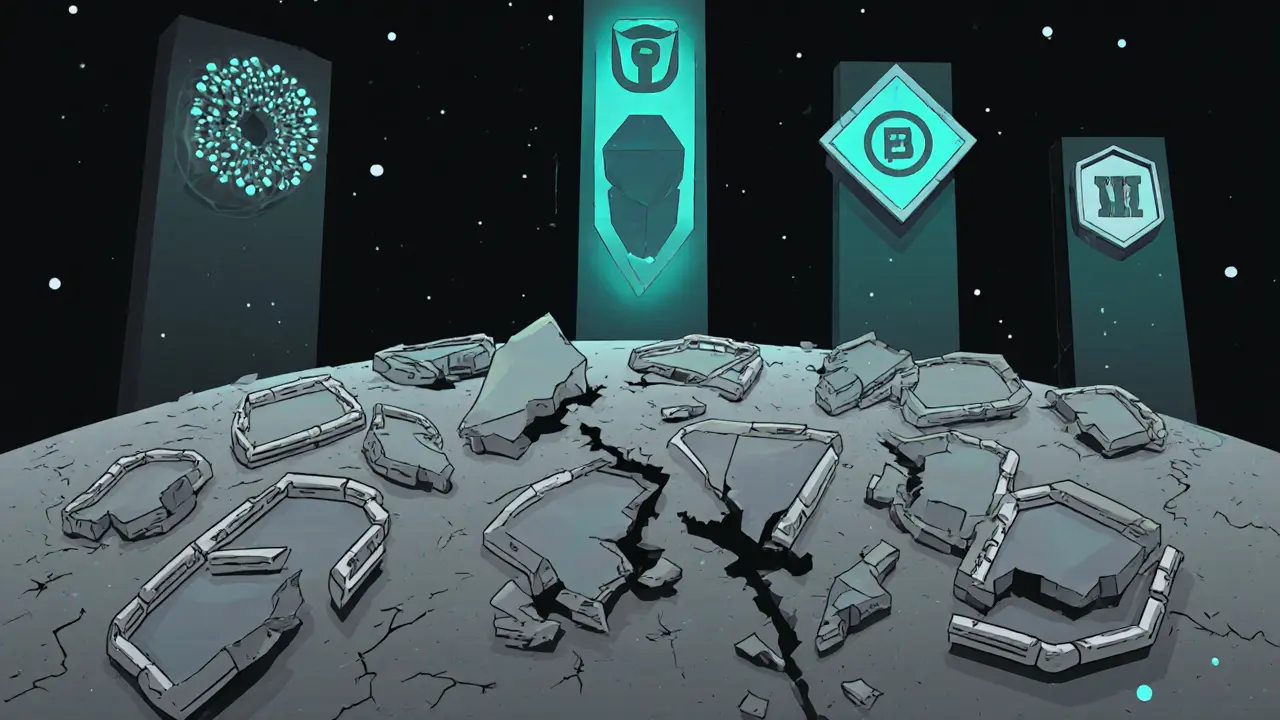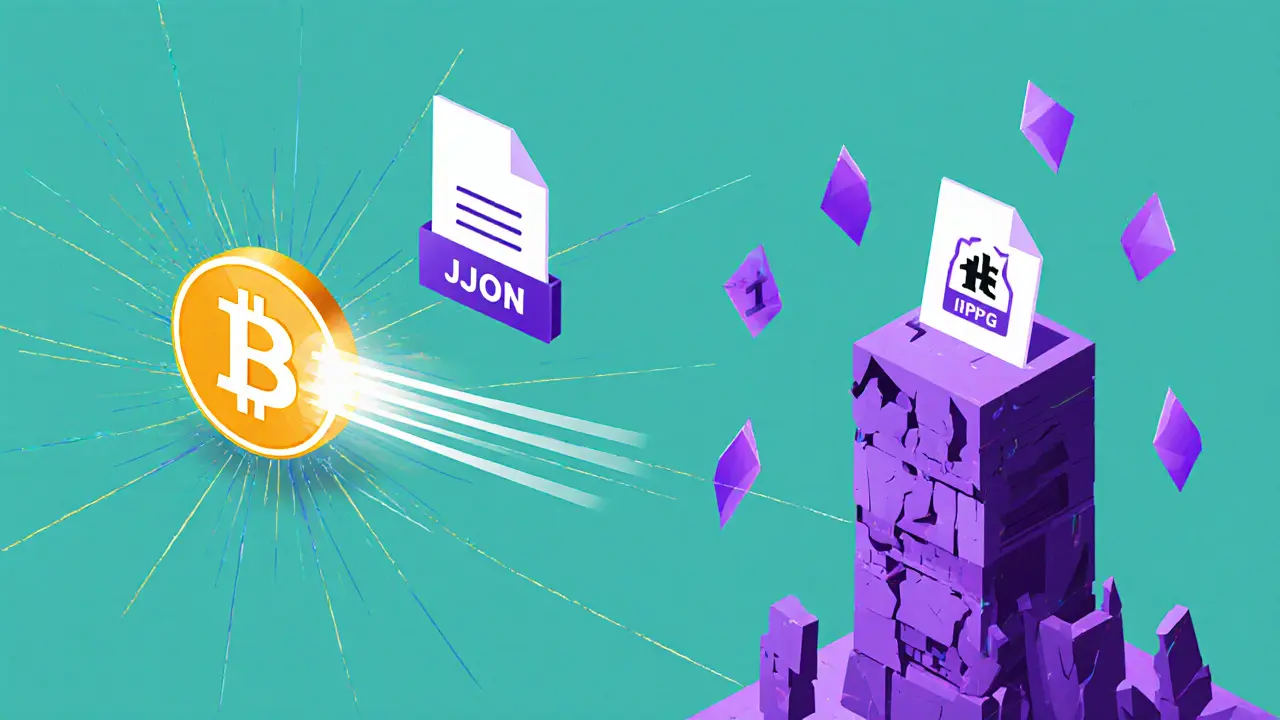NFT Storage Risk Calculator
Storage Configuration
Risk Assessment Results
Risk Level
Cost Estimate
Recommendations
When you buy an NFT, you’re not buying the image, video, or audio file you see. You’re buying a digital receipt - a piece of code on the blockchain that points to something else. That pointer is called NFT metadata. It’s the bridge between what’s locked on the blockchain and what you think you own. Without it, your NFT is just a string of numbers with no picture, no name, no story.
What Exactly Is NFT Metadata?
NFT metadata is data about data. It’s a small JSON file that holds the essentials: the name of the NFT, a description, its traits (like background color or hat style), and most importantly, a link to the actual digital asset - the JPEG, MP3, or 3D model. This metadata is stored on-chain, meaning it’s recorded directly on the blockchain. But the asset itself? That’s almost always stored off-chain.
Think of it like a deed to a house. The deed is on file with the county (on-chain), but the house isn’t. The deed tells you who owns it, what it looks like, and where it’s located. The NFT metadata does the same thing for digital items. It says: ‘This token belongs to this wallet. Here’s what it represents. Here’s where you can find it.’
The standard for this system is ERC-721, introduced on Ethereum in early 2018. It defined how metadata should be structured - fields like name, description, and image. The image field is the critical one. It doesn’t contain the file. It contains a link.
How That Link Works: IPFS, HTTP, and On-Chain Storage
There are three main ways NFT metadata links to digital assets. Each has trade-offs in cost, permanence, and risk.
The most common method - used by about 78% of NFT projects - is IPFS, or InterPlanetary File System. IPFS is a decentralized network where files are stored across thousands of computers. Each file gets a unique hash - a long string like bafybeigdyrzt5sfp7udm7hu76uh7y26nf3efuylqabf3oclzoq366262. That hash is what goes into the NFT’s metadata. When you view your NFT, your wallet or marketplace pulls that hash, finds the file on IPFS, and displays it.
But here’s the catch: IPFS doesn’t automatically keep files alive. Someone has to ‘pin’ them - meaning they actively host the file on their server. If no one pins it, the file disappears after a few days. That’s why services like Pinata and Arweave exist. Pinata is used by 62% of NFT projects and charges $19/month to keep files pinned. Arweave offers permanent storage for about $0.07 per MB, making it popular for high-value collections.
Then there’s centralized HTTP storage. Some projects just link to a regular website - like https://mycoolnft.com/art/123.jpg. This is easy for creators to manage, which is why 85% of Fortune 500 companies use it. But if that server goes down - which happened to Nike’s .SWOOSH platform in February 2023 - your NFT turns into a blank square. No warning. No backup. Just gone.
The third option - on-chain storage - means the actual image or file is embedded directly into the NFT’s code. No links. No external servers. It’s permanent. But it’s expensive. Minting one NFT with full on-chain art costs around 0.25 ETH ($450 as of October 2023), compared to 0.01 ETH ($18) for a metadata-only NFT. Projects like Autoglyphs and CryptoPunks use this method. They’re rare, but they’re the only ones you can truly trust to never break.
Why This Matters: Broken NFTs Are Everywhere
As of September 2023, over 1,200 NFTs across major collections had broken metadata links. That’s not a glitch. It’s a systemic flaw.
Reddit threads are full of horror stories: ‘My $1,200 NFT is just a blank image.’ ‘I bought this Bored Ape, now it’s showing someone else’s monkey.’ In May 2022, a server error at Yuga Labs caused 9,612 Bored Ape NFTs to display wrong metadata for 11 hours. Prices dropped 23% in that time.
Marketplaces aren’t helping. OpenSea’s average rating for metadata reliability is 2.1 out of 5. Rarible is even worse at 1.9. Users don’t complain about the art. They complain about the link breaking.
The most terrifying part? You can’t fix it. Once the link dies, the NFT is broken forever - unless you’re the original creator and you still have the file. Most artists don’t keep copies. They mint, move on, and assume the system will hold up.
Legal Trouble: Owning the Token ≠ Owning the Art
Buying an NFT doesn’t mean you own the copyright. The U.S. Copyright Office made this clear in March 2023: ‘A non-fungible token, by itself, does not convey any rights in the underlying work.’
That’s why artists like Miranda Jiang won $4.2 million in a lawsuit against OpenSea. Someone minted her artwork as an NFT without permission. The metadata pointed to her image, but she never authorized it. The NFT was real. The link was correct. But the rights? None.
Legal cases like Ryder Ripps v. Hermès - a $133 million lawsuit over NFTs mimicking Hermès’ Birkin bags - hinge on whether metadata proves ownership or just copies. Courts are starting to see that metadata isn’t proof of ownership. It’s proof of a link. And links can be forged.

What Creators and Buyers Should Do
If you’re an artist or creator: don’t just use a free NFT minting tool. Ask where your file is stored. If it’s on IPFS, make sure it’s pinned. Use Arweave for permanent storage. Test your NFT after minting. Open it in a wallet. Does the image load? If not, fix it before you sell.
If you’re a buyer: don’t assume your NFT is safe. Check if the collection uses on-chain storage. Look for projects that store metadata on multiple networks - like IPFS + Arweave + a backup server. CryptoPunks does this. That’s why they’ve never had a broken NFT since 2017.
For developers: use tools like Hardhat to automate metadata generation. Test your links. Use the ERC-721 metadata standard correctly. Don’t rely on centralized servers. And never, ever assume the file will stay up forever.
The Future: More Security, Less Risk
Change is coming. Ethereum’s EIP-6454 proposal, submitted in August 2023, aims to freeze metadata after minting so it can’t be changed. That’s a big step toward preventing fraud.
Arweave’s NFT storage has grown 412% since January 2023. More projects are moving toward permanent, decentralized storage. By late 2025, experts predict 68% of new NFTs will use multi-layer storage with 99.99% uptime guarantees.
But until then, treat every NFT like a house with a paper deed - and no actual building. The deed might be perfect. But if the house burns down, you’re still out of luck.
The link between NFT metadata and digital assets isn’t magic. It’s fragile. It’s technical. And if you don’t understand it, you’re not owning an NFT - you’re owning a URL that could vanish tomorrow.

Derayne Stegall
November 17, 2025 AT 12:24Ryan Hansen
November 18, 2025 AT 11:12Shanell Nelly
November 18, 2025 AT 14:02Aayansh Singh
November 19, 2025 AT 19:03Rebecca Amy
November 21, 2025 AT 01:22Darren Jones
November 22, 2025 AT 18:08Kathleen Bauer
November 23, 2025 AT 21:57Carol Rice
November 25, 2025 AT 11:05Laura Lauwereins
November 26, 2025 AT 10:24Gaurang Kulkarni
November 27, 2025 AT 22:56Usama Ahmad
November 28, 2025 AT 06:18Ryan Hansen
November 30, 2025 AT 02:56Astor Digital
December 1, 2025 AT 03:15